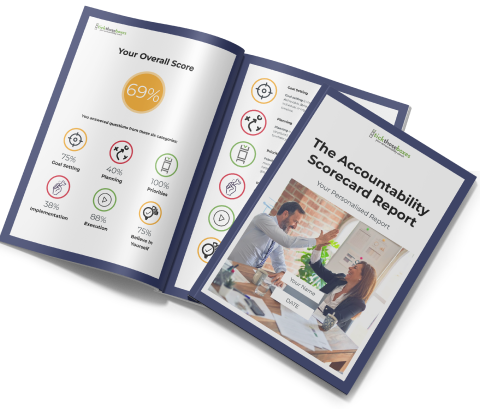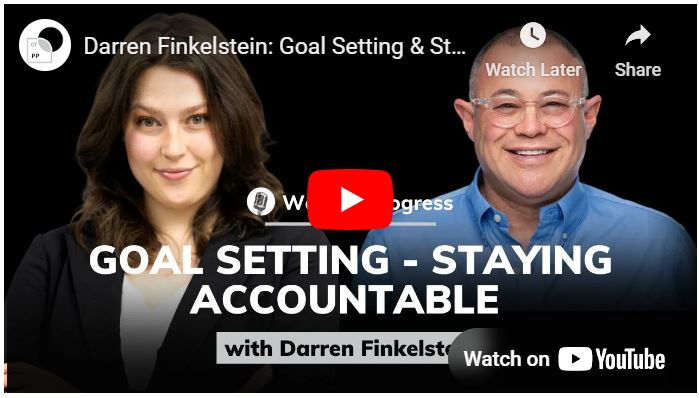Even when a change aims to improve things, it often causes discomfort. That’s especially true for accountability programs, where the shift asks people to take full ownership of their actions, decisions, and outcomes. While these programs strengthen workplace culture, improve communication, and drive better results, they also push people out of their comfort zones. And when that happens, resistance is bound to show up.
Whether it’s subtle hesitation or open pushback, resistance to change in accountability programs is one of the biggest barriers to success. It can disrupt progress, lower morale, and make it challenging to follow through long enough to see real benefits. But understanding why this resistance shows up and how to manage it helps turn these roadblocks into building blocks for stronger, more reliable teams.
Discover your Accountability Score and increase the probability of smashing your GOALS and Getting Sh!t Done!
Understanding Resistance To Change
Resistance doesn’t always come from a place of defiance. In most cases, people resist change because they’re uncertain or worried about their role, about judgement, or about failing in front of others. An accountability program makes performance more visible, and that can feel risky, especially if someone has had negative experiences with blame or unrealistic expectations in the past.
People may also be unsure about what’s expected from them. Confusion can quickly replace cooperation if the accountability program’s rollout was unclear or rushed. Without knowing the reason behind the change or how it will affect daily work, employees may disengage or cling to old habits.
Here are some common reasons people resist accountability changes:
– Fear of failure or looking bad in front of peers
– Lack of trust in leaders or managers
– Past experiences with blame or finger-pointing
– Confusing messaging or unclear expectations
– Feeling overwhelmed by new responsibilities
– Not being given a voice in how the changes are implemented
Emotions play a big role here too. Anxiety, embarrassment, or just plain frustration over having to change routines can all show up when accountability practices are introduced. These reactions usually aren’t personal. They’re often ways for people to protect themselves from discomfort or exposure.
Understanding this kind of resistance is the first step. It’s not about labelling someone as difficult. It’s about recognising that change, especially around personal responsibility, impacts more than just tasks. It can shape how people see themselves at work.
Strategies To Overcome Resistance
Once you understand why people pull back, it becomes easier to build something better. The goal isn’t to force accountability but to build a space where people feel supported enough to grow into it. That happens when they feel informed, heard, and part of the process.
Here are a few steps that help accountability programs take root:
1. Have honest conversations early
Talk about the purpose of the changes and how it benefits everyone, not just leadership. Keep the tone positive and collaborative, not directive.
2. Provide clear expectations
Vague roles and goals cause hesitation. Be clear about what accountability looks like across roles and what’s expected from each person.
3. Involve the team in the rollout
Welcome feedback and suggestions. If people help shape the process, they’ll be more invested in seeing it work.
4. Train and upskill
Equip teams with skills like time management, goal-setting, and prioritising. This reduces fear and provides people tools to succeed.
5. Check in regularly
Frequent, non-judgemental conversations allow space for questions and progress updates. It keeps accountability human and ongoing.
In one company, a new goal-tracking tool was introduced without much preparation. Staff weren’t sure how to use it and feared it would lead to micromanagement. When leadership slowed down and invited feedback, they discovered the real issue was past experiences and lack of clarity. A few walk-through sessions and honest conversations turned the situation around. More people got involved, and the tool’s usage improved with less resistance.
These kinds of experiences show that accountability grows when there’s trust. Trust is built through listening and patience, not through pressure. Managing resistance well opens the path for stronger team habits and better results.
The Role Of An Accountability Coach
When changes depend on shifts in mindset and behaviour, it helps to have someone neutral. An accountability coach brings that perspective. They are not there to assign blame or enforce specific goals. They come in as a guide to help both leaders and teams shift focus, reduce friction, and build better conversations around responsibility.
An accountability coach supports individuals while also helping leadership map out responsibilities and expectations clearly. This middle-ground role means insights are shared early on, before issues become bigger. Because the coach doesn’t sit inside the everyday hierarchy, employees often feel safer to speak freely during coaching sessions. That information helps team leaders respond more effectively.
Some benefits of working with an accountability coach include:
– Guiding team members to take healthy ownership
– Creating clear and aligned expectations across teams
– Setting up ongoing feedback channels
– Encouraging discussion, especially when resistance is high
– Keeping momentum going beyond the initial changes
– Boosting confidence in both leaders and staff
For organisations spaced out between progress and frustration, this kind of coaching can make a difference. It brings structure without making things feel cold or automated. And with that kind of guidance, people become more open to change.
Building A Supportive Culture Around Accountability
Accountability flourishes in workplaces where people feel safe, respected, and aligned on shared values. That kind of environment can’t be created overnight or through a few rules. It shows up in daily actions—from how feedback is given to how wins and failures are treated.
You don’t need a dramatic overhaul. Small, steady steps send the right signals and show that the change is real.
Here are some practical ways to build a better culture of accountability:
– Let leadership model the behaviours first
– Acknowledge effort, follow-through, and ongoing learning
– Respond to challenges without playing the blame game
– Be open about progress and goals so everyone is on the same page
– Make personal accountability a regular part of team check-ins
When culture backs these ideas up, accountability doesn’t feel forced. It becomes part of how things are done. Instead of asking, “Is it safe to take ownership?” people feel confident stepping forward. It also removes the fear that accountability is just about blame or setting traps.
Ensuring Long-Term Success
Treating any accountability program as a one-time fix puts it at risk of fading out. If the energy fades, the change disappears. Real success comes from habit, not hype.
That’s why consistency matters. Long-term progress comes when accountability becomes part of regular conversations, feedback loops, and reviews. It must be more than just a goal-setting session once a quarter.
Here are some ways to keep accountability strong over time:
1. Regular check-ins tied to progress, not just deadlines
2. Open forums to share updates and ask questions
3. Tracking systems that show clear actions and outcomes
4. Recognition for positive effort and progress
5. Flexibility to adapt processes when they stop working
Even something simple—like 15-minute team catch-ups each week—can keep everyone connected to their task and role. These chats surface misunderstandings early and quickly bring things back in line.
Without these regular touchpoints, it becomes easier for people to slide back into old routines. Accountability isn’t just a checklist—it’s a rhythm. And when leaders stay in tune, people follow.
Embrace Change For Lasting Growth
When done right, accountability programs shape how the whole organisation operates. But change isn’t smooth. It comes with discomfort, uncertainty, and a fair bit of resistance. Fortunately, we can overcome all these challenges with the right support, clarity, and structure.
Change doesn’t stick unless it feels worth it. That means helping people understand why, giving them a say in how, and supporting them through what comes next. With the right systems, conversations, and coaching in place, teams not only adjust—they begin to thrive.
The hardest part of making behavioural changes is getting started. The next most difficult part is sticking with it. But when people begin seeing even small wins—and feel encouraged, not judged—those changes take hold for real.
True accountability becomes not just a task or a target but a part of how things are done around here. It becomes a culture of showing up, following through, and working together.
“Tick Those Boxes” specialises in helping individuals and organisations become more accountable. Contact our team to see how our programs may help you establish a more effective and accountable workplace, allowing you to do the things you say you will do and get your teams to do the same.
To implement these strategies effectively and foster a culture of growth, consider working with an accountability coach. They provide the guidance and support needed for smooth transitions. With clearer roles, consistent feedback, and improved follow-through, your team can adapt more confidently.


